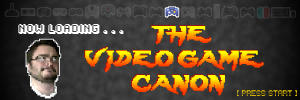
The following is part of Now Loading, a series that renders verdicts on whether or not your favorite video games deserve a place in the canon of works that have contributed to video-game storytelling in landmark ways. Read the series’ full mission statement here.
Here We Go Again!
Ladies and gentlemen, shy guys and shy gals, hello and welcome to Now Loading…The Video Game Canon! The only weekly Internet column that takes a look at games from the past to determine whether they should be remembered in the future.
Well folks, now that we’re a week out of our Ooky Spooky Canon Toonies month, I could sure as hell use a pick-me-up. Don’t get me wrong, I love delving into emotional turmoil and existential dread as much as the next guy, but after a month of poring over different bits of the Silent Hill lore and revisiting some of the more tragic characters that the interactive medium has to offer, I’m in the market for something a bit more bright and cheerful.
And folks, when you’re in need of a quick and powerful injection of pure, unadulterated, joyous fun, the Doctor is in. Doctor Mario, that is. Well alright, not Doctor Mario, the puzzle game, although that game is a great deal of fun. Just Mario. Super Mario.
We’re looking at Super Mario Sunshine this week, is my point.
I, like many of you, have spent the greater part of my last two weeks on this planet indulging in the unabashed explosion of fun that is Super Mario Odyssey, and it had me jonesing to write a piece about Nintendo’s Mustachioed Golden Boy. And while I wanted to indulge in a long Canon piece gushing about what a great, nostalgic time I had playing through the many and varied levels of Odyssey, the simple fact of the matter is that not enough time has passed for me to feel that I can fairly analyze it.
What the Canon aims to do, if you’ll pardon the pun, is take a look back at games that have had enough time to let the dust of initial excitement settle around them so that we can truly appreciate the game for what it has to offer, and not just for the hype that surrounded it upon release. So for those of you expecting a typical Canon-style piece on Odyssey, give it a few months and we’ll be on it like moths to a flame.
So, in the meantime, let’s take a look at Super Mario Sunshine, shall we?
Something that has always struck me as odd about this game is the mixed reaction from fans and critics it has received years after its initial release. When Sunshine first came out in the summer of 2002, everyone and their Mama Luigi went nuts over it. Because it was a 3D platforming game in which the player runs around various different levels and worlds collecting stars and coins, Sunshine was largely seen as the sequel to the juggernaut that was Super Mario 64. You ran, jumped, and yahoo-ed as Mario traversed a number of unique, cartoonish worlds, all connected by a hub-world, in order to collect 120 stars (“shine sprites” in this game) so that you could save Princess Peach from the evil Bowser.
And while it had these similarities, there were enough changes that Sunshine didn’t feel like a lazy re-skin of 64. Instead of the rolling green hills of the Mushroom Kingdom, you were exploring the sandy beaches of the tropical Isle Delfino. Instead of fighting Bowser from the beginning of the game, you are initially after a Shadowy Mario Imposter who, through many twists and turns in the story, is revealed to have a connection to our favorite lizard king. And in perhaps the biggest change to the gameplay, instead of having only your abilities to run and jump as Mario, you are given a jetpack/water-pump apparatus that lets you extend your jumps, hover in the air, and even blast off into the stratosphere for intense super jumps. Between these changes to the gameplay and story, and the obvious graphical upgrade that the GameCube had over the Nintendo 64, it would seem on paper that Super Mario Sunshine was the perfect sequel to Super Mario 64.
So why would people dislike it?
Well, Dear Reader, here’s where we come to the crux of the Mario dilemma. When a new iteration of a game comes out, whether it be Super Mario, The Legend of Zelda, or even Call of Duty, fans and critics alike seem to be of two cognitively dissonant mindsets. On the one hand, people expect the latest entry into a long-running series to be new and innovative, with exciting features added that spice up the series and take it in new directions. On the other hand, those same people have such an attachment to the games that came before the new entry that they want certain staples of the classics to be represented as well.
What results, at least from a development standpoint, is a tightrope situation in which the new game must be innovative and fresh while at the same time being nostalgic and repetitive. This situation, more often than not, results in people disliking the new and interesting aspects of a game that they once asked for, because they are too dissimilar from the old game that made them love the series in the first place. Luckily, as you’ll see, Super Mario Sunshine offers just enough innovation while still sticking to its roots, and ultimately serves as both an amazing sequel to Super Mario 64 and a perfect standalone game.
But this introduction has gone on far too long, eh? Let’s explore this idea of old-versus-new more in-depth by donning some overalls, hiking up our sleeves, and jumping into Super Mario Sunshine.
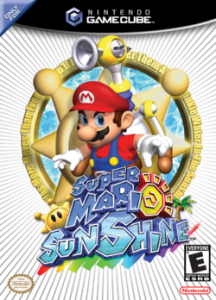
Story and Characters: Bowser, What are YOU Doing Here?!
Going forward into this section, I’m going to do something that a writer never should, and assume that you have at least brushed up against the basic storyline of a Super Mario title. But, for the uninitiated, here’s a brief synopsis: every major Mario game before Sunshine has the same story—namely, the evil dragon Bowser kidnaps the demure Princess Peach, and so the selfless plumber Mario sets off to rescue her. These are simple tropes we have seen many times before, and they act as a simple structural framework around which fun and interesting levels can be designed for the player to explore. In this way, the story in most Mario games is secondary to the platforming and exploring in the gameplay.
And yet, in an example of that old-versus-new paradox I mentioned earlier, Super Mario Sunshine differed from its predecessors by adding something to the story that had never before been present: intrigue. Yes, Sunshine still has the core story of Peach getting kidnapped and Mario having to save her, but there are other story elements present that actually entice you to progress, beyond the simple goal of collecting all the stars.
We begin with Mario, Peach, and a number of Toads from the Mushroom Kingdom flying to the beautiful Isle Delfino for a tropical vacation. It would seem that after years of being kidnapped and rescued, Peach is ready for a bit of much earned R&R, and, as she is a nice friend, she’s invited Mario along with her. While they are watching an in-flight movie telling them about all the wonderful conveniences and beautiful locales that Isle Delfino has to offer, they have a bit of a bumpy landing due to some gross sludge on the runway.
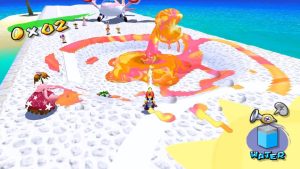
Hmm. Gross! Mop it up!
Mario and the gang deplane and begin to investigate the ooze blocking their way. As some of the Toads remark on how the ooze seems almost like paint, Peach looks into the distance and sees a shadowy figure that she swears looks just like Mario. Mario goes over to investigate, whereupon he sees a small jetpack-looking object that comes to life and introduces itself as the “Flash Liquidizer Ultra Dousing Device,” or “F.L.U.D.D.” for short. Mario straps the new device onto his back, and starts trying to clean up the ooze that was blocking their way. After a few spurts from F.L.U.D.D., a giant piranha plant made of muck emerges from the ooze, and a fight begins.
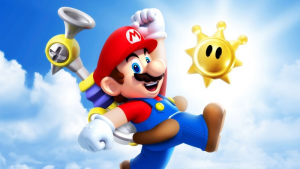
After the fight is when things go pear-shaped, because Mario is taken away by the local police under suspicion of defacing public property all over the island. It seems that that shadowy figure whom Peach saw in the distance is masquerading as Mario and mucking up the whole island. As he spreads his goopy graffiti, the island’s Shine Sprites, which are like Power Stars from Super Mario 64, have been disappearing, which has led to the entire island being covered not only in muck, but also in a dark and depressing shadow.
“Some vacation this is turning out to be,” mocks the studio audience.
So, after a trial (yes, Mario is put on trial in this game), our hero is sentenced to community service, using F.L.U.D.D. to clean up all the graffiti in order to bring the Shine Sprites, and thus the sunshine, back to Isle Delfino.
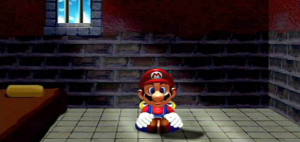
“It’s only because of their stupidity that they’re able to be so sure of themselves.”-It’s a Me, Kafka
But all is not so simple, because the impostor known as Shadow Mario is still running around the island and causing trouble, and, true to the Mario villain motif, he kidnaps Peach on multiple occasions. Eventually, it is revealed that Shadow Mario is actually Bowser Jr. in disguise, and he is trying to kidnap Peach because he is under the impression that she is his mother. This obviously causes some confusion for all involved parties, including the player and any passing biologists, but it’s quickly dismissed as being untrue as the story progresses.
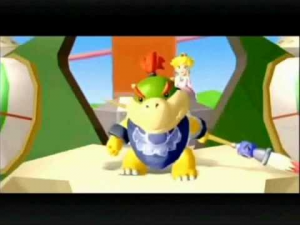
After collecting enough Shine Sprites, Mario and F.L.U.D.D. make their way to the top of the Mt. Corona, the island’s volcano where Bowser Jr. and his father have stolen away with Peach. After a pretty comical final boss fight in a hot tub, Mario and F.L.U.D.D. are victorious, Bowser and his bratty kid are defeated, and Peach and company finally get to have their vacation, now that Mario has cleared his name.
I will go on record as saying that this is by far my own personal favorite Mario story, because it is the only one that includes the phrase, “After Mario’s trial and short incarceration…” Never change, Nintendo.
The biggest difference between Sunshine and the previous Mario titles, as I see it, comes with how much the story embraces its goofiness. Between Mario’s wrongful imprisonment, his evil twin, and Bowser’s family drama, Sunshine’s story plays out like a Super Mario Soap Opera, and they wholeheartedly run with how silly the whole setup is.
It seems that a lot of this game’s detractors don’t care for that silliness, but what they tend to overlook is just how silly Mario games have always been. Granted, traditionally it was the gameplay itself that was silly, what with all the goofy cartoon characters that you stomp on and the mushrooms you eat; all Sunshine did differently, though, was construct a plot that was just as nonsensical, goofy, and fun as the gameplay for which these games are known.
Speaking of which!
Gameplay, Music, and Visuals: Fun Times with Weapons
The biggest change in Sunshine’s gameplay as compared to Super Mario 64 was the inclusion of the F.L.U.D.D. device, which added a whole new dimension to the 3D platforming aspects of this game. Whereas in 64 you only relied on Mario’s jump, double jump, triple jump, side jump, and ground pound to maneuver your way through the different levels, F.L.U.D.D. lets you do all those different jumps as well as hover in place, expand your jump with a burst of water, and also stun enemies by spraying them in the face. By virtue of being on the more technologically advanced GameCube, Sunshine boasts much bigger levels than 64, and so it makes sense that Mario has a device that allows him to jump higher and longer, as well as cover greater distance as he makes his way across Isle Delfino.
Along with the island and beach theme of the levels, the game is heavily designed around water and how you can use it in different ways. While water has a great impact on platforming, it also plays a big role in how you fight different enemies and bosses. Previous Mario games had Mario simply jump on or throw his enemies, but since the water-powered F.L.U.D.D. is such an integral part of this game, Sunshine’s boss fights are all designed around disorienting them with a water jet, boosting your jump so that you can perform a walloping ground pound on them, or, in the case of Petey Piranha, just soaking them until they can’t move any longer.
The important thing to note about Sunshine is that it added a new mechanic in F.L.U.D.D., but didn’t cripple the player by making them only use the jetpack or the spray nozzle. You need to use it in certain circumstances, sure, but you still have all the same Mario moves that you have come to know and love from previous installments in the series. In so doing, Nintendo blended a new mechanic with old mechanics seamlessly, and whether or not you think it works simply comes down to that tightrope-walking personal preference I mentioned earlier.
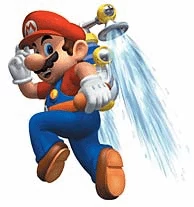
F.L.U.D.D. added a new dimension to both platforming and boss fights in Mario without committing the mistake of completely removing things players were used to, and in that way the gameplay is both new and interesting while also being familiar to long-time players.
The music in Super Mario Sunshine is simply phenomenal. Like the gameplay, it manages to weave in themes from the older games into new pieces of music that makes the score both nostalgic and new. Take the “Shadow Mario Theme” that plays when you are chasing Bowser Jr. throughout a level: it takes the basic, lazy melody of the “Underground Theme” from Super Mario Bros. and energizes it into a jazzy chase theme that fits into the grimy, conniving character of Shadow Mario.
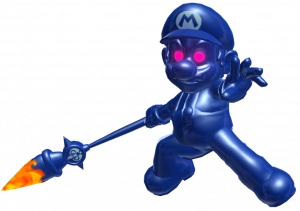
And then of course there’s “Delfino Plaza,” which manages to be a completely new song in keeping with the upbeat island aesthetic of Delfino and its inhabitants, while still capturing the happy-go-lucky feeling you get when running around as Mario. It’s happy, upbeat, and screams, “Welcome to Our Island!”
Masterful Nintendo composer Koji Kondo was behind the music for this game, and it shows. As he’s shown with his compositions for The Legend of Zelda, Kondo has a knack for bottling the essence of a game, transposing it onto sheets of music, and then delighting both the ear and heart of the player.
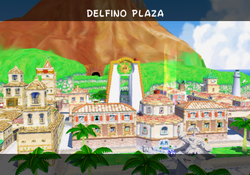
So lovely.
Lastly, for a game that calls itself Sunshine, Nintendo outdoes itself in terms of character design, level design, and the general island/beach motif for which it is striving. Between the rolling vistas of Bianco Hills, the carnivalesque Pinna Park, and the gorgeous Noki Beach, every level in the game perfectly fits in with the idea that Isle Delfino is a beautiful vacation spot. The Pianta and Noki are especially cute and fun to interact with, and the enemy designs are different enough to their designs in 64 that you feel Mario has left the Mushroom Kingdom and truly gone somewhere else. There is so much in the visual design that is new and innovative, while at the same time providing that same cartoonish aesthetic that Super Mario titles are known for. In a word, this game just looks pleasant.
Oh, old and new, you are indeed a sweet combo.
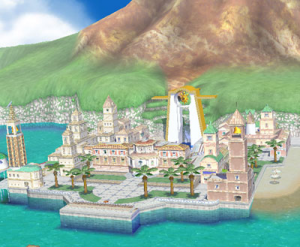
Impact on Video Gaming and Culture: It’s Okay to Be Weird
Although Super Mario Sunshine isn’t remembered with the same reverence as its predecessor, it has jet-blasted a particularly nostalgic niche for itself amongst Super Mario fans. As I mentioned earlier, it was released to critical and player acclaim, and managed to be the third-highest selling game for the GameCube, with 5.5 million copies sold by the end of 2006. And while it was a commercial success, I see it as being far more important to Nintendo than just a best-seller. For as amazing and innovative as Super Mario 64 was, it could have easily been seen as a miraculous fluke if its successor hadn’t been just as amazing.
Consider a world in which there was no Super Mario Sunshine, but instead a Super Mario 64: 2. Instead of traveling to the resort island of Delfino with Peach and meeting Bowser Jr., the game opens with Mario getting another letter.
“Hey Mario,
I made another cake for you or whatever who cares. Come over or something.
-PEACH”
And instead of strapping on F.L.U.D.D., Mario jumped out of that same green pipe and ran up to Peach’s castle again. “Oh no!” Cries a Toad. “Bowser has Peach and has also taken the 120 Power Stars! Again!” Instead of unraveling this weird story about Bowser Jr. thinking Peach is his mother, you run around the same old worlds and same old halls, and only a few things are tweaked here and there to make you think the game is more different than it actually is, when really it’s just Super Mario 64: Again.
But we didn’t get that. We didn’t get a boring rehash of a game we loved. We got Super Mario Sunshine, a fun new adventure in a totally new place with our favorite plumber!
In my opinion, Sunshine opened the door for Mario sequels to take bigger and better risks with their storytelling and gameplay. Sunshine’s success showed Nintendo that, as long as a new game had some of those old favorites, they could take crazy risks with other things. Say, like, shooting Mario into space and turning him into a bee?
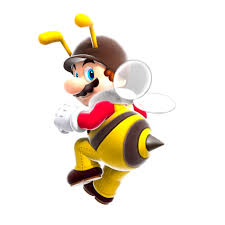
It’s a bee, Mario.
So Sunshine may not be remembered as breaking through the sound barrier with its genius like Super Mario 64, but, in many ways, it stands as an important milestone for Nintendo:
We like weird, new ideas.
BONUS LEVEL: We’ll Get ‘im Next Time!
This particular “Bonus Level” section is more of a general musing of mine about one of the aspects of the Super Mario games that warms me to my core: the feeling that every character is aware of how fun and silly everything is, and that it’s all a show being put on for someone else. This was maybe most famously alluded to in Super Mario Bros. 3, in which all the levels are actually sets for a play—it’s as if Mario, Bowser, and Peach got some money together and said, “Hey, this one’s really gonna blow them away!”
This idea comes up in all the Mario Kart games and various sports titles as well, where, instead of Mario and Bowser being at each other’s throats all the time, they’re amicably playing tennis or just having a grand ole time karting a few laps around the track. It’s just a wholesome idea that reinforces the fact that Mario is essentially the Mickey Mouse of video games, and that all these games we play with him are as much for his good time as it is for ours. In this regard, there’s a little moment towards the end of Sunshine that just warms my heart every time I see it.
After Mario and F.L.U.D.D. beat Bowser and Bowser Jr., the island’s sunshine is restored, and all the citizens rejoice with Mario. Bowser and his son are floating away from the island on a raft, and as they are watching the celebration take place, they have this little exchange.
Bowser looks over to his son, and says, “Jr., I’ve got something kinda difficult to tell ya…” at which point his son says, “I know Peach isn’t really my mama.” Bowser looks shocked, like he wasn’t expecting his son to have picked up on that lie he told him. After all, it’s pretty obvious he just told him that so that his kid would have a motive to kidnap Peach and bring him back to dear old dad. There’s a moment of silence, like Bowser is dumbfounded at how smart his kid is; then Bowser Jr. turns to him, smiles, and says, “Someday, I wanna fight that Mario again!”
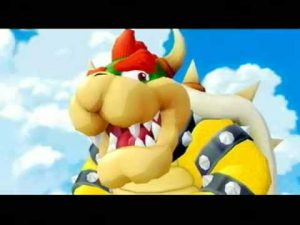
Every father dreads the “I’m a Lizard and she’s a lady, so let’s talk about reproductive possibility” talk.
Bowser laughs, throws out a “That’s my boy!” and then says how well and good that is, but now it might be better just to rest.
I love this little exchange, because it shows that Mario, Bowser, and Peach all know that this is all gonna happen again, and none of them is deterred or saddened by that. It’s all part of the fun, and Bowser’s so proud that his son understands it’s all about the fight and not about the prize. It’s about putting on a show and having a fun time—and just think about how much fun we’ll have next time!
And we will have fun, Dear Reader, because that’s what Mario offers. Pure, unadulterated fun that everyone is in on. Even the baddies.
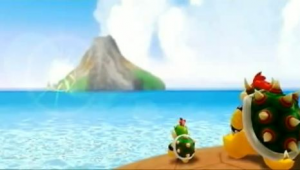
VERDICT: SHINE GET!
I know it seems obvious to call a Mario title a classic, but that’s exactly what I’m doing. Super Mario Sunshine is not only a blast to play through, but it also came at an important time in Mario’s history. It showed that Super Mario 64 and 3D Mario games weren’t just flukes or flashes in the pan, and proved that these games had real, lasting staying power that would influence how Nintendo continued with not only the Super Mario franchise, but other long-running series like The Legend of Zelda and Super Smash Bros as well. The game melds innovation with nostalgia perfectly, and is nothing but a bucket of laughs.
So welcome, Super Mario Sunshine, to the Video Game Canon!
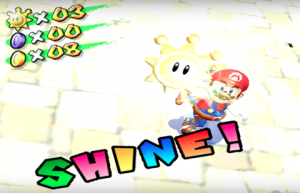
Yahoo!



